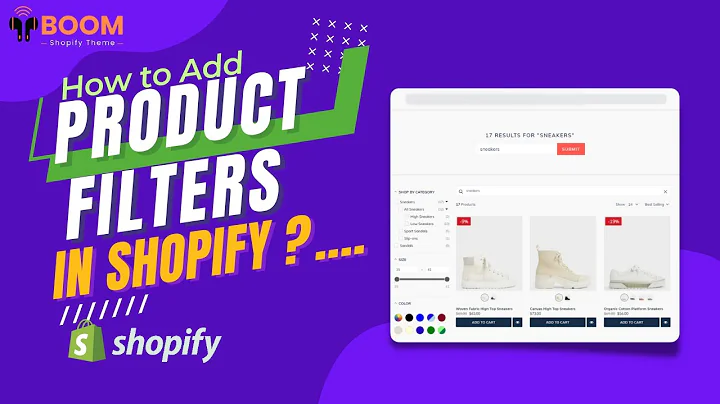Optimize Your Shopify Store for Dropshipping Success
Table of Contents:
- Introduction
- Importance of Organizing Products
- Setting up Categories
- Renaming and Editing Product Titles, Descriptions, and Variants
- Creating a Special Category for Viral Products
- Creating a Menu for Easy Navigation
- Customizing the Theme's Design
- Setting up the Home Page
- Removing Unnecessary Sections
- Creating a Featured Collection for Viral Products
- Creating Additional Featured Collections
- Adding an Email Newsletter Section
- Adding a Footer with Store Policies and Social Media Links
- Editing the Collection Page
- Optimizing the Products Page
- Conclusion
How to Optimize Your Shopify Store for dropshipping Success
Dropshipping has become an increasingly popular business model for entrepreneurs looking to start their own online stores. With the advancement of e-commerce platforms like Shopify, setting up a dropshipping store has never been easier. However, simply launching a store is not enough to guarantee success. In order to stand out from the competition and drive conversions, it is essential to optimize your Shopify store for maximum visibility and user experience.
1. Introduction
In this article, we will guide you through the process of optimizing your Shopify store for dropshipping success. We will cover various aspects of store setup and customization to ensure that your products are organized, easily accessible, and appealing to your target audience. By following these steps, you will be able to create a store that not only attracts customers but also converts them into paying customers.
2. Importance of Organizing Products
One of the main reasons why general dropshipping stores lose conversions is the lack of organization. Customers who come from social media platforms, such as TikTok, often struggle to find the specific product they saw in a video. They become overwhelmed by the disorganization and extensive product range, leading them to leave the store without making a purchase. Therefore, organizing your products into categories is vital for providing a seamless customer experience and preventing potential sales loss.
3. Setting up Categories
To begin organizing your products, you need to assign a category to each individual item. Shopify provides pre-existing categories that you can choose from, making the process simple and efficient. Select the appropriate category for each product and create collections based on these categories. This ensures that customers can easily navigate through your store, locate the products they are interested in, and make a purchase without any hassle.
4. Renaming and Editing Product Titles, Descriptions, and Variants
In order to enhance the professionalism and trustworthiness of your store, it is essential to go the extra mile and rename your product titles, edit your descriptions, and customize your variants. The default product titles generated by importing products from AliExpress may appear spammy and untrustworthy to customers. By taking the time to edit these elements, you can make your store appear more authentic and credible, thereby increasing the likelihood of customer trust and conversion.
5. Creating a Special Category for Viral Products
As part of your store optimization, it is beneficial to create a separate category for viral products. These are products that are currently gaining significant attention on social media platforms. By tagging products as viral, you can highlight them and attract customers who are specifically interested in trending items. This category serves as a powerful marketing tool, allowing you to ride the wave of popular demand and increase sales potential.
6. Creating a Menu for Easy Navigation
To ensure seamless navigation within your Shopify store, it is crucial to create a well-structured menu. This menu should include links to all your collections, as well as a home link for easy access. By organizing your menu categories logically and intuitively, customers will find it effortless to explore your store and locate their desired products. A well-designed menu enhances the overall user experience and minimizes bounce rates.
7. Customizing the Theme's Design
Shopify offers a variety of themes to choose from, with the option to customize them according to your brand's aesthetic. Select a theme that aligns with your store's niche and target audience, and then customize its colors, fonts, and layout. By creating a visually appealing and engaging store design, you can capture the attention of potential customers and establish a strong brand identity.
8. Setting up the Home Page
The home page is where you make your first impression on visitors, so it needs to be well-optimized and organized. Remove any unnecessary sections or elements that do not contribute to the overall user experience. Instead, focus on creating featured collections that showcase your best-selling or trending products. Highlight these products using high-quality visuals, compelling descriptions, and user-friendly features such as quick add buttons and product ratings.
9. Editing the Collection Page
The collection page is where customers can browse products within specific categories. Similar to the home page, remove any irrelevant sections and optimize the layout for ease of navigation. Customize the image ratio, show product ratings, and enable quick add buttons to streamline the browsing and purchasing process. By creating an organized and visually appealing collection page, you can guide customers towards making a purchase.
10. Optimizing the Products Page
The products page is the heart of your Shopify store, where customers can access detailed information about each individual item. Ensure that all product titles, descriptions, and variants are accurately represented and edited for maximum appeal. Improve the user experience by displaying product ratings and enabling quick add buttons. By providing comprehensive and visually appealing product information, you can instill confidence in customers and increase the likelihood of conversion.
11. Conclusion
Optimizing your Shopify store for dropshipping success requires careful attention to detail and a customer-centric approach. By organizing your products, customizing your store's design, and enhancing the user experience, you can create a store that stands out from the competition and drives conversions. Remember to continuously analyze and improve your store's performance based on customer feedback and market trends. With dedication and consistent effort, your dropshipping store can become a profitable and sustainable business venture.
Highlights:
- Organizing products into categories enhances the customer experience.
- Renaming and editing product titles, descriptions, and variants improves store credibility.
- Creating a special category for viral products boosts sales potential.
- Designing a well-structured menu simplifies navigation for customers.
- Customizing the theme's design creates a visually appealing store.
- Optimizing the home page, collection page, and products page drives conversions.
FAQs:
Q: Can I create multiple categories for my products?
A: Yes, you can create as many categories as needed to accurately organize your products and facilitate customer navigation.
Q: How can I highlight trending products in my store?
A: By tagging viral products, you can create a dedicated category that showcases trending items and attracts customers interested in popular products.
Q: Is it necessary to edit the default product titles and descriptions?
A: Editing product titles and descriptions is highly recommended to make your store appear more professional and trustworthy to potential customers.
Q: What are the benefits of customizing my store's theme?
A: Customizing your store's theme allows you to create a unique and visually appealing design that aligns with your brand identity, attracting and engaging customers.
Q: How often should I analyze and improve my store's performance?
A: Regularly analyzing customer feedback and market trends, and making adjustments accordingly, is essential for maintaining a successful dropshipping store.






















